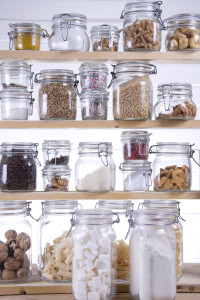Six Easy Tips for Reducing your Plastic Exposure in the Kitchen
 Plastics are everywhere, especially in the kitchen! Plastic storage containers, plastic cooking utensils, plastics in your food processor, blender, etc. They definitely make our lives easier, but they come with their share of troubles. Hard plastics contain BPA (bisphenol- A), a proven carcinogenic substance and endocrine disruptor. Soft plastics contain phthalates, another kind of additive in plastics which are used to make plastics more soft and flexible, and are another type endocrine disrupting chemical that we have to be aware of.
Plastics are everywhere, especially in the kitchen! Plastic storage containers, plastic cooking utensils, plastics in your food processor, blender, etc. They definitely make our lives easier, but they come with their share of troubles. Hard plastics contain BPA (bisphenol- A), a proven carcinogenic substance and endocrine disruptor. Soft plastics contain phthalates, another kind of additive in plastics which are used to make plastics more soft and flexible, and are another type endocrine disrupting chemical that we have to be aware of.
Heat, acidity, abrasion, oil and time increase the rate at which these toxic substances permeate your food. Have you ever noticed that when you store tomato sauce in plastic containers that sometimes your container is permanently orange? This is because plastics consist of strings of polymers, put together in a specific way to make certain plastics. These polymers are not tightly bound and are constantly falling off depending on what they come into contact with. In this case oil and acidity are increasing the rate at which your pasta sauce seeps into your plastic container. So you don’t have tomato sauce stuck on your plastic container, it’s actually in the plastic. It’s difficult to absolutely eliminate your exposure to toxins, but we can definitely reduce it. This is why I promote toxic-less living at Clean Body Living.
Here are my top tips for reducing your plastic exposure in the kitchen.
1. Replace your plastic food storage containers with glass ones. It is easy to find glass food storage containers these days. They are everywhere from Target and Walmart to Bed, Bath and Beyond.
2. Replace your plastic cooking utensils (spatulas, spoons, etc.) with stainless steel ones. Replacing your cooking utensils will greatly reduce your exposure to the chemicals in plastics. Remember that heat increases that rate at which chemicals permeate your foods, so replacing your cooking utensils is a must.
3. Wash any other plastics in your kitchen with the soft side of the sponge and NEVER put those items in the dishwasher (even though it says that you can.). It’s impracticable to get rid of every single plastic in the kitchen. For the plastics that we have left, like in our juicers, blenders and food processors, make sure to wash them with the soft side of the sponge because remember that abrasion is another factor that makes plastics leach into your food. The dishwasher combines two of the ways that plastics leach into your food – heat and abrasion, so never put them in the dishwasher. This goes for the tops for your glass food storage containers as well.
4. Get a stainless steel or glass water bottle. These are easy to find at Whole Foods, any other natural foods store, Walmart or Target. Instead of buying water in plastic bottles, try to get a water bottle that doesn’t have BPA or phthalates.
5. Store your produce in your crisper instead of in plastic bags. It took me a while to realize exactly what a crisper was for – to keep your produce crisp! There is no need to keep all of that plastic in your fridge.
6. NEVER EVER microwave food in plastic or Styrofoam containers. Remember that heat increases the rate at which chemicals permeate your food, so the heat from your microwave will do just that. Microwave your food in glass or ceramic and cover your food with a paper towel when it’s in there, not with plastic!
There are so many other chemicals in plastics and they cause many other problems, but if you start with these six tips, you’ll significantly reduce your exposure to plastics and the associated risks!
Now it’s your turn. I would love to hear what you learned and whether you have any other tips for reducing plastic exposure in the kitchen. Let me know in the comments below.
– AmiCietta







Since BPA has become such a hot news item, the relsubae water bottle business has been booming. I drink from glass bottles and jars at home, but when I’m going places where sharp impacts are a possibility (i.e. when I leave my room), I opt for stainless steel. No mystery liners or leaching toxins to worry about!You can get a in pretty much any size or color you could want nowadays. Another good sign about stainless steel water bottles; I see people around who have obviously had their Klean Kanteen for years, and it’s still going strong.
Yes, Klean Kanteens are definitely durable. Great to hear that you’re going with glass and stainless steel and not BPA-free. Check out my latest blog post about why BPA-free plastics are just as bad as those with BPA.